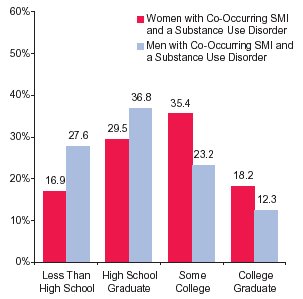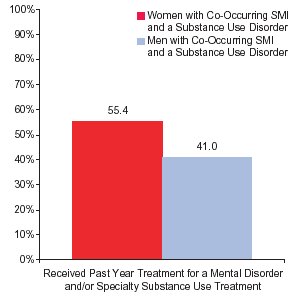
 |
| August 20, 2004 |
|
In Brief |
|
Recent research has found that women admitted to substance abuse treatment with co-occurring psychiatric and substance use disorders were less likely to be in the labor force and less likely to have been referred for treatment by the criminal justice system than women admitted to substance abuse treatment with no psychiatric disorder.1 Additional research also has identified differences between women with co-occurring mental and substance use disorders and their male counter-parts.2 Compared with men, women with co-occurring mental and substance use disorders were more likely to seek help in mental health and outpatient settings, have poorer job skills, and suffer from serious physical health problems.
The National Survey on Drug Use and Health (NSDUH) includes questions for adults aged 18 or older to assess serious mental illness (SMI) during the year prior to the survey interview. Individuals are classified as having SMI if at some time during the past year they had a mental, behavioral, or emotional disorder that met criteria specified in the Diagnostic and Statistical Manual of Mental Disorders, 4th edition (DSM-IV)3, and that resulted in functional impairment that substantially interfered with or limited one or more major life activities. NSDUH measures SMI using the K-6 distress questions.4,5 NSDUH also includes a series of questions to assess dependence on or abuse of alcohol or illicit drugs. Illicit drugs include marijuana/hashish, cocaine (including crack), inhalants, hallucinogens, heroin, and prescription-type drugs used nonmedically. These questions are designed to measure dependence and abuse based on criteria specified in the DSM-IV. For the purpose of this report, individuals with either alcohol or drug dependence or abuse are said to have a substance use disorder. Individuals with both SMI and a substance use disorder are said to have co-occurring SMI and a substance use disorder.
NSDUH respondents are also asked about their experiences with treatment for a mental problem and with specialty substance use treatment during the past year. Treatment for a mental problem is defined as the receipt of services in any inpatient or outpatient setting for "problems with emotions, 'nerves', or mental health" in the 12 months prior to the interview. Treatment also includes the use of prescription medication for a mental or emotional condition.6 Specialty substance use treatment is defined as treatment for substance use received at alcohol or drug rehabilitation facilities (inpatient or outpatient), hospitals (inpatient only), or mental health centers.7
In 2002, 11.4 million women aged 18 or older were estimated to have had SMI. This represents almost 11 percent of all adult women. Almost 6 percent (6.4 million) of women aged 18 or older were estimated to have a substance use disorder in the past year. Almost 2 million women aged 18 or older were estimated to have both SMI and a substance use disorder. This represents almost 2 percent of all adult women. In comparison, about 6 million men aged 18 or older (6 percent of men) were estimated to have SMI in the past year, 13.4 million men (13 percent) had a substance use disorder, and over 2 million men (2 percent) had co-occurring SMI and a substance use disorder.
Figure 1. Current Employment Status among Women Aged 18 or Older with a Past Year Substance Use Disorder, by Co-Occurring SMI: 2002 |
 |
Analyses of the 2002 NSDUH data found that women aged 18 and older8 with co-occurring SMI and a substance use disorder were less likely to perceive their health status as "excellent" than women with a substance use disorder but no SMI during the past year. For example, women with co-occurring SMI and a substance use disorder aged 18 to 25 were significantly less likely to perceive their health status as "excellent" (12 percent) compared to women in the same age category with a substance use disorder only (25 percent) (data not shown).
Women with co-occurring SMI and a substance use disorder were less likely to be employed full-time than their counterparts with a substance use disorder only (49 vs. 56 percent) (Figure 1). The rates of past-year criminal justice involvement (arrest, probation, or parole/supervised release or conditional release) were similar among women with co-occurring SMI and a substance use disorder and women with a substance use disorder only. Both groups of women were similar in terms of race/ethnicity and marital status.
Forty-eight percent of the estimated 4 million adults with co-occurring SMI and a substance use disorder were women. Analyses of the 2002 NSDUH data found that almost 17 percent of women with co-occurring SMI and a substance use disorder had not completed high school compared with 28 percent of men with co-occurring SMI and a substance use disorder (Figure 2). Although family income levels were similar among men and women with co-occurring SMI and a substance use disorder, women were more likely to have current health insurance (77 percent) than men (67 percent). Women with co-occurring SMI and a substance use disorder also were more likely to have received treatment for a mental problem and/or specialty substance use treatment during the past year than their male counterparts (55 vs. 41 percent, respectively) (Figure 3).
Figure 2. Level of Education Attainment among Adults with Co-Occurring SMI and a Substance Use Disorder, by Gender: 2002 |
Figure 3. Percentages of Adults with Co-Occurring SMI and a Substance Use Disorder Who Received Treatment in the Past Year, by Gender: 2002 |
 |
 |
* 'Other' includes retired persons, disabled persons, homemakers, students, or other persons not in labor force.
| The National Survey on Drug Use and Health (NSDUH) is an annual survey sponsored by the Substance Abuse and Mental Health Services Administration (SAMHSA). Prior to 2002, this survey was called the National Household Survey on Drug Abuse (NHSDA). The 2002 data are based on information obtained from 68,126 persons aged 12 or older, including 44,481 persons aged 18 or older. The survey collects data by administering questionnaires to a representative sample of the population through face-to-face interviews at their place of residence.
The NSDUH Report is prepared by the Office of Applied Studies (OAS), SAMHSA, and by RTI International in Research Triangle Park, North Carolina (RTI International is a trade name of Research Triangle Institute). Information and data for this issue are based on the following publication and statistics: Office of Applied Studies. (2003). Results from the 2002 National Survey on Drug Use and Health: National findings (DHHS Publication No. SMA 03–3836, NSDUH Series H–22). Rockville, MD: Substance Abuse and Mental Health Services Administration. Also available online: http://www.oas.samhsa.gov. Because of improvements and modifications to the 2002 NSDUH, estimates from the 2002 survey should not be compared with estimates from the 2001 or earlier versions of the survey to examine changes over time. |
| The NSDUH Report (formerly The NHSDA Report) is published periodically by the Office of Applied Studies, Substance Abuse and Mental Health Services Administration (SAMHSA). All material appearing in this report is in the public domain and may be reproduced or copied without permission from SAMHSA. Additional copies of this report or other reports from the Office of Applied Studies are available on-line: http://www.oas.samhsa.gov. Citation of the source is appreciated. |
| | |
 |
Click to Return to OAS Home Page |
|
This page was last updated on August 26, 2004.
| |